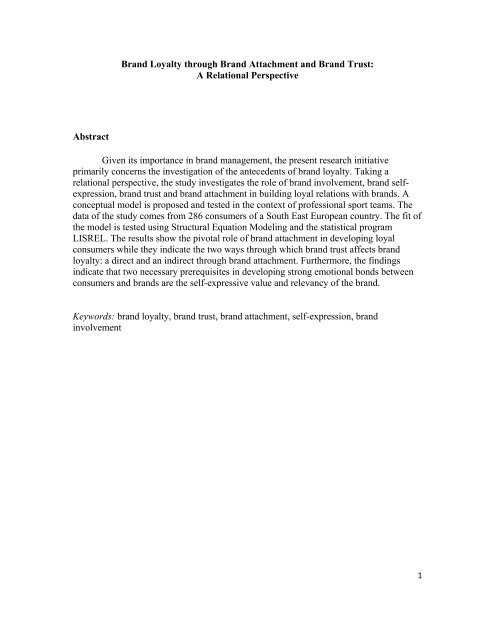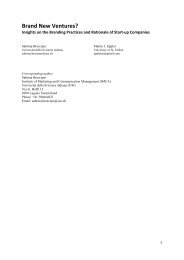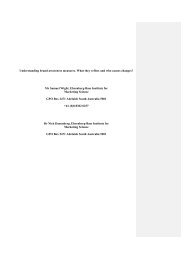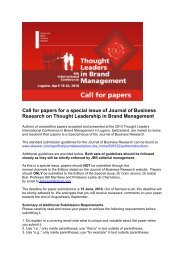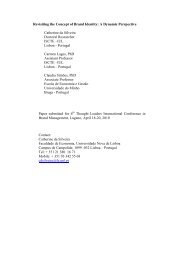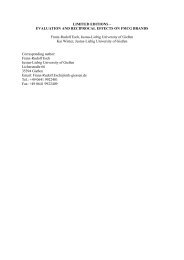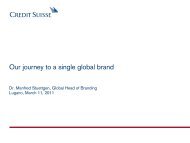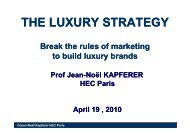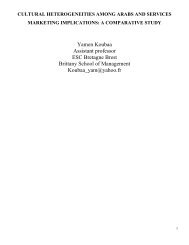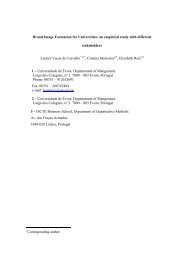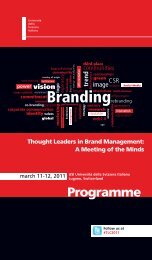Brand Loyalty through Brand Attachment and Brand Trust - Thought ...
Brand Loyalty through Brand Attachment and Brand Trust - Thought ...
Brand Loyalty through Brand Attachment and Brand Trust - Thought ...
You also want an ePaper? Increase the reach of your titles
YUMPU automatically turns print PDFs into web optimized ePapers that Google loves.
<strong>Br<strong>and</strong></strong> <strong>Loyalty</strong> <strong>through</strong> <strong>Br<strong>and</strong></strong> <strong>Attachment</strong> <strong>and</strong> <strong>Br<strong>and</strong></strong> <strong>Trust</strong>:<br />
A Relational Perspective<br />
Abstract<br />
Given its importance in br<strong>and</strong> management, the present research initiative<br />
primarily concerns the investigation of the antecedents of br<strong>and</strong> loyalty. Taking a<br />
relational perspective, the study investigates the role of br<strong>and</strong> involvement, br<strong>and</strong> selfexpression,<br />
br<strong>and</strong> trust <strong>and</strong> br<strong>and</strong> attachment in building loyal relations with br<strong>and</strong>s. A<br />
conceptual model is proposed <strong>and</strong> tested in the context of professional sport teams. The<br />
data of the study comes from 286 consumers of a South East European country. The fit of<br />
the model is tested using Structural Equation Modeling <strong>and</strong> the statistical program<br />
LISREL. The results show the pivotal role of br<strong>and</strong> attachment in developing loyal<br />
consumers while they indicate the two ways <strong>through</strong> which br<strong>and</strong> trust affects br<strong>and</strong><br />
loyalty: a direct <strong>and</strong> an indirect <strong>through</strong> br<strong>and</strong> attachment. Furthermore, the findings<br />
indicate that two necessary prerequisites in developing strong emotional bonds between<br />
consumers <strong>and</strong> br<strong>and</strong>s are the self-expressive value <strong>and</strong> relevancy of the br<strong>and</strong>.<br />
Keywords: br<strong>and</strong> loyalty, br<strong>and</strong> trust, br<strong>and</strong> attachment, self-expression, br<strong>and</strong><br />
involvement<br />
1
<strong>Br<strong>and</strong></strong> <strong>Loyalty</strong> <strong>through</strong> <strong>Br<strong>and</strong></strong> <strong>Attachment</strong> <strong>and</strong> <strong>Br<strong>and</strong></strong> <strong>Trust</strong>:<br />
A Relational Perspective<br />
1. Introduction<br />
<strong>Br<strong>and</strong></strong> loyalty is placed at the center of contemporary br<strong>and</strong> management,<br />
especially in markets where competition is fierce <strong>and</strong> product differentiation limited.<br />
Oliver (1999) defines br<strong>and</strong> loyalty as “a deeply held commitment to re-buy or repatronize<br />
a preferred product/service consistently in the future, thereby causing repetitive<br />
same-br<strong>and</strong> or same br<strong>and</strong>-set purchasing, despite situational influences <strong>and</strong> marketing<br />
efforts have the potential to cause switching behavior” (p. 34). Companies are focusing<br />
on br<strong>and</strong> loyalty strategies because they create entry barriers to competitors, <strong>and</strong> generate<br />
greater sales <strong>and</strong> profits whereas loyal consumers become less vulnerable to competitors’<br />
actions (Dick <strong>and</strong> Basu, 1994; Ballester <strong>and</strong> Aleman, 2001) <strong>and</strong> less price sensitive<br />
(Birgelen et al., 1997). Moreover, br<strong>and</strong> loyalty is directly related to reduced marketing<br />
costs, increased new customers (Aaker, 1991), favorable word of mouth (Dick <strong>and</strong> Basu,<br />
1994) while it mediates the relationship between br<strong>and</strong> attitudes <strong>and</strong> br<strong>and</strong> equity<br />
(Ch<strong>and</strong>huri, 1999).<br />
Given its importance in br<strong>and</strong> management, it is surprising that research on<br />
consumer behavior literature is usually confined to specific sources of br<strong>and</strong> loyalty (e.g.<br />
perceived quality <strong>and</strong> satisfaction) <strong>and</strong> the do not fully explore the mechanisms <strong>through</strong><br />
which loyalty is developed. The present research endeavor primarily concerns the<br />
relationships between br<strong>and</strong> trust, br<strong>and</strong> attachment, <strong>and</strong> br<strong>and</strong> loyalty. This perspective<br />
adopts a relational view <strong>and</strong> is interested in the relational aspects of br<strong>and</strong> loyalty<br />
(Fourner, 1998; Fournier <strong>and</strong> Yao, 1997). In this sense, consumers typically create<br />
loyalty relationships with a range of br<strong>and</strong>s; this may include several br<strong>and</strong>s associated<br />
with the same category of goods (Uncles et al., 1995). Previous approaches to br<strong>and</strong><br />
loyalty are confined to outcomes of utilitarian <strong>and</strong> cognitive decision-making processes,<br />
failing to capture the relationship aspect of br<strong>and</strong> consumption (Fournier, 1998). In line<br />
with this reasoning, Fournier, (1998) indicates the lack of attention devoted to<br />
interpersonal relationship theories in spite their theoretical connections to loyalty, <strong>and</strong><br />
their applicability in other areas in the marketing literature.<br />
Thus, the present study adopts a relational perspective in examining the<br />
antecedents of br<strong>and</strong> loyalty <strong>and</strong> therefore it characterizes the relationship between the<br />
br<strong>and</strong> <strong>and</strong> the consumer in terms of trust <strong>and</strong> attachment. The purpose of this research is<br />
twofold. First, the study aims to contribute to the br<strong>and</strong> literature by conceptualizing the<br />
formation of br<strong>and</strong> loyalty. Second, several of the proposed relations have not been tested<br />
before in the marketing literature (e.g. the link between br<strong>and</strong> self expression <strong>and</strong> br<strong>and</strong><br />
attachment, <strong>and</strong> the link between br<strong>and</strong> involvement <strong>and</strong> br<strong>and</strong> attachment). This<br />
investigation analyzes the effects of br<strong>and</strong> self expression, br<strong>and</strong> involvement, <strong>and</strong> br<strong>and</strong><br />
trust on the emotional attachment between the consumer <strong>and</strong> the br<strong>and</strong>, which in turn<br />
affects the consumers’ br<strong>and</strong> loyalty. Thus, the proposed framework aims to provide an<br />
underst<strong>and</strong>ing of the antecedents of br<strong>and</strong> attachment <strong>and</strong> the mechanism that converts<br />
br<strong>and</strong> trust <strong>and</strong> br<strong>and</strong> attachment into br<strong>and</strong> loyalty when building consumer-br<strong>and</strong><br />
relations.<br />
2
The paper is organized as follows. First, based on the related literature, the<br />
conceptual model is presented along with the study hypotheses. The research<br />
methodology <strong>and</strong> the results obtained constitute the next two sections. The article<br />
concludes with a discussion of the findings, its theoretical <strong>and</strong> managerial implications<br />
<strong>and</strong> future research recommendations.<br />
2. Conceptual model – Research hypotheses<br />
As mentioned previously, this endeavor takes a relationship marketing perspective<br />
(Chaudhuri <strong>and</strong> Holbrook, 2001; Fournier, 1998; Fournier <strong>and</strong> Yao, 1997; Morgan <strong>and</strong><br />
Hunt, 1994) centered on the emotional aspects of br<strong>and</strong> relationships (Veloutsou, 2007).<br />
Based on the emerging theory of br<strong>and</strong> attachment (Park et al. 2006), the present study<br />
proposes that br<strong>and</strong> trust <strong>and</strong> br<strong>and</strong> attachment determine br<strong>and</strong> loyalty. The<br />
hypothesized relationships among the constructs of the study are shown on Figure 1.<br />
2.1. The antecedents of br<strong>and</strong> loyalty: <strong>Br<strong>and</strong></strong> attachment <strong>and</strong> br<strong>and</strong> trust<br />
<strong>Br<strong>and</strong></strong> attachment refers to “the strength of the cognitive <strong>and</strong> affective bond<br />
connecting the br<strong>and</strong> with the self” (Park et al. 2006, p. 4) in a symbolic manner<br />
(Wallendorf <strong>and</strong> Arnould, 1988). Fournier (1994) has proposed br<strong>and</strong> attachment as one<br />
of the six dimensions relevant in a consumer-br<strong>and</strong> relationship. The significance of<br />
br<strong>and</strong> attachment as a key determinant in consumer consumption behavior is<br />
substantiated by several attributes inherent to the concept. <strong>Attachment</strong> expresses<br />
emotional bonds which are persistent, resist to change, impact cognition, <strong>and</strong> predict<br />
behavior (Krosnick <strong>and</strong> Petty, 1995). Persistence reflects the degree to which an<br />
individual's attachment toward an object remains unchanged over time. Resistance<br />
represents an individual’s ability to refuse shifting to competitive products (Petty <strong>and</strong><br />
Cacioppo, 1986). A strong attachment will lead to consumer’s resistance to change <strong>and</strong><br />
the ability of a br<strong>and</strong> to withst<strong>and</strong> bad performance (Keller et al., 2008).<br />
Park et al.’ s (2006) posit that br<strong>and</strong> attachment is more than an attitudinal<br />
construct <strong>and</strong> accounts for higher-order consumer behaviors associated with commitment<br />
to a relationship. Thus, br<strong>and</strong> attachment is a characteristic of the relationship between a<br />
consumer <strong>and</strong> a br<strong>and</strong> leading to “automatic retrieval of thoughts <strong>and</strong> feelings about the<br />
br<strong>and</strong>” (Park et al., 2006).<br />
Recently, affective reactions to br<strong>and</strong>s have been found to predict br<strong>and</strong> loyalty.<br />
Empirical studies report that br<strong>and</strong> affect determines purchase <strong>and</strong> attitudinal loyalty<br />
(Chaudhuri <strong>and</strong> Holbrook, 2001) whereas br<strong>and</strong> attachment directly influences br<strong>and</strong><br />
loyalty (Thomson et al., 2005). Therefore, we expect that:<br />
H1. <strong>Br<strong>and</strong></strong> attachment is positively related to br<strong>and</strong> loyalty<br />
Originated in social psychology, trust is viewed as an intrinsic feature of any<br />
valuable social relationship. <strong>Br<strong>and</strong></strong> trust constitutes an important construct in marketing<br />
because it affects consumers’ positive <strong>and</strong> favorable attitudes, <strong>and</strong> results in br<strong>and</strong><br />
commitment (Ballester <strong>and</strong> Aleman, 2001), an expression of successful relationships<br />
3
etween consumers <strong>and</strong> br<strong>and</strong>s. <strong>Br<strong>and</strong></strong> trust refers to ‘the willingness of the average<br />
consumer to rely on the ability of the br<strong>and</strong> to perform its stated functions’ (Chaudhuri<br />
<strong>and</strong> Holbrook, 2001, p. 82). Based on the commitment-trust theory, Morgan <strong>and</strong> Hunt<br />
(1994) consider trust as a key variable in developing <strong>and</strong> maintaining enduring <strong>and</strong><br />
highly valued br<strong>and</strong> relationships.<br />
Research reports that br<strong>and</strong> trust is a predictor of consumers’ br<strong>and</strong> commitment,<br />
even stronger than overall satisfaction (Ballester <strong>and</strong> Aleman, 2001), <strong>and</strong> it is linked<br />
directly to purchase <strong>and</strong> attitudinal loyalty with the br<strong>and</strong> (Chaudhuri <strong>and</strong> Holbrook,<br />
2001). Therefore, it is hypothesized that:<br />
H2. <strong>Br<strong>and</strong></strong> trust is positively related to br<strong>and</strong> loyalty<br />
2.2. The antecedents of br<strong>and</strong> attachment – <strong>Br<strong>and</strong></strong> trust, br<strong>and</strong> self expression <strong>and</strong><br />
br<strong>and</strong> involvement.<br />
<strong>Br<strong>and</strong></strong> attachment is closely related to consumers’ self-concept. According to Part<br />
et al. (2006) four conditions/resources are necessary for a br<strong>and</strong> to foster br<strong>and</strong><br />
attachment: to “1) gratify the self <strong>through</strong> hedonic <strong>and</strong> aesthetic qualities, 2) enable the<br />
self by fostering a sense of efficacy <strong>and</strong> control, 3) enrich the self by providing symbolic<br />
meanings that define one’s identity, <strong>and</strong> 4) can do so reliably <strong>and</strong> with the customer’s<br />
interest at heart” (p. 23, 24). The first three conditions indicate the self expressive value<br />
of the br<strong>and</strong> while the fourth is related to self-assuring trust with a br<strong>and</strong>. Therefore, we<br />
propose that br<strong>and</strong> self-expression, involvement <strong>and</strong> trust account for consumers’ br<strong>and</strong><br />
attachment.<br />
Carroll <strong>and</strong> Ahuvia (2006) defined a self-expressive br<strong>and</strong> as “the consumer’s<br />
perception of the degree to which the specific br<strong>and</strong> enhances one’s social self <strong>and</strong>/or<br />
reflects one’s inner self” (p.82). It is well documented in the consumer behavior literature<br />
that individuals choose specific br<strong>and</strong>s not only for their functional benefits but also for<br />
their symbolic properties (Piacentini <strong>and</strong> Mailer, 1999; Wattanasuwan, 2005). In this<br />
case, the symbolic meaning of the br<strong>and</strong> is used as an expression of a consumer’s selfconcept<br />
in relation to her / his status in society (Elliot, 1999). Consumers choose br<strong>and</strong>s<br />
that assist them in creating, fostering <strong>and</strong> developing their identity (Elliot <strong>and</strong><br />
Wattabasuwan, 1998; Yoo et al., 2006). When br<strong>and</strong>s gratify, enrich <strong>and</strong> enable<br />
consumers’ self then, consumers will develop strong emotional bonds with them <strong>and</strong><br />
therefore, build consumer-br<strong>and</strong> relations (Part et al., 2006). Following the above<br />
discussion it is hypothesized that:<br />
H3. <strong>Br<strong>and</strong></strong> self-expression is positively related to br<strong>and</strong> attachment.<br />
<strong>Br<strong>and</strong></strong> trust has been considered an important <strong>and</strong> desired quality in underst<strong>and</strong>ing<br />
consumer-br<strong>and</strong> relationships <strong>and</strong> therefore, achieving successful relationship marketing<br />
(Morgan <strong>and</strong> Hunt, 1994; Chaudhuri <strong>and</strong> Holbrook, 2001; Park et al. 2006). When<br />
consumers trust a br<strong>and</strong>, they will commit to a relationship with the br<strong>and</strong> <strong>and</strong> be willing<br />
to sustain a long-term relationship with it. Because the trust-commitment relationship is<br />
4
considered pivotal in relationship marketing (Morgan <strong>and</strong> Hunt, 1994), br<strong>and</strong> trust has<br />
been mainly examined in relation to br<strong>and</strong> commitment <strong>and</strong> not to br<strong>and</strong> attachment,<br />
although the latter is perceived as an expression of br<strong>and</strong> commitment. For example,<br />
Chaudhari <strong>and</strong> Holbrook (2001), <strong>and</strong> Kennedy et al. (2000) examined the relationship<br />
between trust <strong>and</strong> commitment for consumer products <strong>and</strong> report positive effects.<br />
However, Park et al. (2006) consider br<strong>and</strong> trust crucial in fostering br<strong>and</strong> attachment<br />
because consumers rely upon the br<strong>and</strong> to consistently deliver its resources. To the<br />
author’s knowledge only one study (Esch et al., 2006) examined the effect of br<strong>and</strong> trust<br />
on br<strong>and</strong> attachment reporting a strong positive effect (.75), stronger than br<strong>and</strong><br />
satisfaction (.19). Consequently, it is proposed that:<br />
H4. <strong>Br<strong>and</strong></strong> trust is positively related to br<strong>and</strong> attachment.<br />
Involvement is regarded as a primary determinant of consumer behavior <strong>and</strong> has<br />
been defined as ‘a person's perceived relevance of the object based on inherent needs,<br />
values, <strong>and</strong> interests (Zaichkowsky, 1985, p. 342). Involvement is a function of<br />
individual characteristics (e.g. needs, values, goals), situational factors (e.g. purchase<br />
occasion or perceived risk associated with a purchase decision), <strong>and</strong> characteristics of the<br />
product or stimulus (e.g. type of the media, variations within a product class)<br />
(Zaichkowsky, 1985). The consequences of involvement are higher motivation,<br />
heightened arousal <strong>and</strong> increases in cognitive elaborations (Mano <strong>and</strong> Oliver, 1993).<br />
Zaichkowsky (1985) distinguished involvement into two categories: product involvement<br />
<strong>and</strong> br<strong>and</strong>-decision involvement. Product involvement refers to the interest consumer<br />
finds in a product class. <strong>Br<strong>and</strong></strong>-decision involvement is the interest taken in making the<br />
br<strong>and</strong> selection. To the author’s knowledge, the role of involvement in relation to br<strong>and</strong><br />
attachment has not been studied yet. Involvement has been studied in relation to br<strong>and</strong><br />
commitment either as an antecedent or as a moderator. Thus, involvement has been found<br />
to be an antecedent of br<strong>and</strong> loyalty <strong>and</strong> br<strong>and</strong> commitment (Beatty <strong>and</strong> Kahle, 1988) <strong>and</strong><br />
to act as a moderator in the relationship between br<strong>and</strong> trust <strong>and</strong> br<strong>and</strong> commitment<br />
(Ballester <strong>and</strong> Aleman, 2001). Because br<strong>and</strong> attachment is considered an indicator of<br />
br<strong>and</strong> commitment, br<strong>and</strong> involvement is considered here as an antecedent of br<strong>and</strong><br />
attachment hypothesizing that:<br />
H5. <strong>Br<strong>and</strong></strong> Involvement is positively related to br<strong>and</strong> attachment.<br />
3. Method<br />
The target population for this research is the sport industry <strong>and</strong> specifically,<br />
professional sport teams. The particular industry is of great importance due to its<br />
characteristics <strong>and</strong> continuous marketing developments. Sport teams are highly symbolic<br />
<strong>and</strong> experiential products that allow for the development of strong emotional bonds<br />
between them <strong>and</strong> their fans. Moreover, recognizing the benefits of br<strong>and</strong>ing <strong>and</strong><br />
capitalizing on the emotional attachment of their fans, sports teams are consistently<br />
turned into br<strong>and</strong> management strategies in order to instil fan trust <strong>and</strong> foster loyalty<br />
(Desbordes, 2007).<br />
5
A single industry approach was taken because it allows developing questions<br />
understood by all respondents, it provides a degree of control over environmental<br />
particularities <strong>and</strong> it increases internal validity at the expense of its findings’<br />
generalizability (Dobni <strong>and</strong> Luffman, 2000). Furthermore, because causal relationships<br />
are tested, a single industry investigation is more appropriate for inference purposes.<br />
Data were collected from a questionnaire distributed to sport fans of various<br />
teams in a Southeast European country. A total of 286 completed questionnaires were<br />
collected.<br />
3.1. Construct operationalisation <strong>and</strong> measures<br />
<strong>Br<strong>and</strong></strong> Involvement: A revised version of the Personal Involvement Inventory<br />
(PII) (Zaichkowsky, 1994), consisting of 10 items (7-point bipolar scale), was used to<br />
measure br<strong>and</strong> invovlement. The scale encompasses two dimensions of involvement,<br />
importance <strong>and</strong> pleasure. The mean score of the two dimensions were used as the two<br />
indicators of br<strong>and</strong> involvement.<br />
<strong>Br<strong>and</strong></strong> Self-Expression: To measure the self-expressive value of the br<strong>and</strong>, the<br />
instrument developed by Carroll <strong>and</strong> Ahuvia (2006) was employed. Their scale consists<br />
of two factors: inner self (4 items) <strong>and</strong> social self (5 items) <strong>and</strong> uses a seven point Likert<br />
scale anchored by Strongly Disagree (1) to Strongly Agree (7).. The mean score of the<br />
two factors were used as the two indicators of br<strong>and</strong> self-expression.<br />
<strong>Br<strong>and</strong></strong> <strong>Attachment</strong>: Eight items were initially used to measure br<strong>and</strong> attachment.<br />
The items were initially proposed <strong>and</strong> tested in a sport context by James <strong>and</strong> Ross (2002).<br />
Four items measure the degree to which an individual has a felt commitment to their team<br />
<strong>and</strong> four additional items assess the extent to which an individual has internalized the<br />
team within his/her self-concept. Respondents responded to the items using a seven point<br />
Likert scale anchored by Strongly Disagree (1) to Strongly Agree (7).<br />
<strong>Br<strong>and</strong></strong> <strong>Trust</strong>: Four items using a 7-point likert-type scale anchored by Strongly<br />
Disagree (1) to Strongly Agree (7) were initially used to measure trust. These items have<br />
been used before in the marketing literature (Chaudhuri <strong>and</strong> Holbrook, 2001).<br />
<strong>Br<strong>and</strong></strong> <strong>Loyalty</strong>: <strong>Br<strong>and</strong></strong> loyalty was measured with nine items used in the marketing<br />
literature (Zeithaml et al., 1996). The first four items measure br<strong>and</strong> loyalty, <strong>and</strong> the<br />
remaining 5 measure loyalty intentions using a seven point Likert scale anchored by<br />
Strongly Disagree (1) to Strongly Agree (7).. The mean scores of the two sub-scales were<br />
used as the two indicators of br<strong>and</strong> loyalty.<br />
4. Results<br />
First, a confirmatory factor analysis (CFA) was used for testing the measurement<br />
model <strong>and</strong> then, structural equation modelling (SEM) was deployed to test the theorized<br />
model (Figure 1).<br />
4.1. Confirmatory factor analysis<br />
The initial 18 items used to measure the five latent constructs were subjected to<br />
Confirmatory Factor Analysis (CFA) using LISREL 8.52. CFA was employed to test the<br />
6
proposed theoretical framework <strong>and</strong> to verify uni-dimensionality <strong>and</strong> convergent validity.<br />
Several items were dropped from the analysis due to small loadings (Table 1). The<br />
revised measurement model consisted of 12 items <strong>and</strong> was found to fit the data well with<br />
the chi-square goodness of fit index not being statistically significant (χ 2 =110.47 with 44<br />
degrees of freedom, ratio χ 2 / d.f.=2.5, <strong>and</strong> p=.123). When the chi-square value is not<br />
significant, the model is an adequate representation of the data (Hoyle, 1995). Moreover,<br />
the fit indexes values met or exceeded the critical values for good model fit (RMSEA =<br />
0.07, NFI = 0.96, GFI = 0.94, CFI = 0.98).<br />
Next, internal consistency was evaluated by using Cronbach α <strong>and</strong> composite<br />
reliability (CR). The Cronbach α for the latent variables ranged from 0.83 to 0.93, well<br />
above the recommended 0.70 cut-off point. Both composite reliability (CR) <strong>and</strong> average<br />
variance extracted (AVE) were calculated using the procedures recommended by Fornell<br />
<strong>and</strong> Larker (1981). As shown on Table 1 all the composite reliabilities for the seven<br />
multi-item scales ranged from 0.64 to 0.95, indicating acceptable levels of reliability for<br />
the constructs. Moreover, the AVEs ranged between 0.80 <strong>and</strong> 0.94, well above the<br />
recommended 0.50 level (Bagozzi <strong>and</strong> Yi, 1988). Finally, the model was tested for<br />
convergent <strong>and</strong> discriminant validity by using the factor loadings <strong>and</strong> the Φ matrix. These<br />
two tests indicated that the conditions for convergent <strong>and</strong> discriminant validity were<br />
satisfied indicating that the constructs are measured reliably <strong>and</strong> can be discriminated.<br />
4.2. The structural model<br />
After the preliminary analyses, the structural model of the study was tested using<br />
the statistical package LISREL 8.52 <strong>and</strong> employing Maximum Likelihood (ML). The<br />
proposed model (Figure 1) did fit the data well with a chi square value of 129.47 (ratio χ 2<br />
/ df=2.8), <strong>and</strong> 46 degrees of freedom (p=.00). The fit indexes values were larger than the<br />
0.90 threshold (NFI = 0.96, GFI = 0.93, CFI = 0.97) <strong>and</strong> the RMSEA value was close to<br />
the acceptable levels (0.08), another indication of the good model fit. All the<br />
hypothesized effects were confirmed with all paths being significant at the .05 level as<br />
Figure 1 shows. The total, direct <strong>and</strong> indirect effects on the endogenous variables of the<br />
proposed model were all significant whereas all constructs used in the model presented<br />
significant positive direct <strong>and</strong>/or indirect effects.<br />
With respect to the explained variance of the endogenous variables, 87% of the<br />
variance on <strong>Br<strong>and</strong></strong> <strong>Loyalty</strong> was explained by the model. Moreover, 83% of the variance<br />
on <strong>Br<strong>and</strong></strong> <strong>Attachment</strong> was explained by <strong>Br<strong>and</strong></strong> <strong>Trust</strong>, <strong>Br<strong>and</strong></strong> Involvement <strong>and</strong> <strong>Br<strong>and</strong></strong> Self<br />
Expression.<br />
5. Discussion of findings <strong>and</strong> future research directives<br />
This study provides important contributions, both in theory <strong>and</strong> praxis, for the<br />
study <strong>and</strong> practice of br<strong>and</strong> loyalty. <strong>Br<strong>and</strong></strong> trust, br<strong>and</strong> attachment <strong>and</strong> br<strong>and</strong> loyalty are<br />
relevant constructs in the relationship marketing literature, which considers them as key<br />
mediating variables in relational exchanges (Morgan <strong>and</strong> Hunt, 1994). In this line, br<strong>and</strong><br />
loyalty can be perceived as a link in the sequence of effects that indirectly connects br<strong>and</strong><br />
7
trust <strong>and</strong> br<strong>and</strong> attachment with the market performance features of br<strong>and</strong> equity<br />
(Chaudhuri <strong>and</strong> Holbrook, 2001).<br />
Consistent with past findings, the pattern of results reported here suggest that<br />
br<strong>and</strong> attachment is a direct determinant of br<strong>and</strong> loyalty whereas br<strong>and</strong> trust affects<br />
br<strong>and</strong> loyalty in two ways: one direct <strong>and</strong> one indirect via br<strong>and</strong> attachment. The findings<br />
confirm the proposed model <strong>and</strong> highlight the important role of br<strong>and</strong> attachment in<br />
developing br<strong>and</strong> loyalty. The current research provides an empirical validation of the<br />
conceptual framework proposed by Park et al. (2006) <strong>and</strong> verifies the role of selfexpressive<br />
factors (br<strong>and</strong> self-expression <strong>and</strong> br<strong>and</strong> involvement) <strong>and</strong> trust in developing<br />
br<strong>and</strong> attachment. The study also extends this framework to the outcomes of br<strong>and</strong><br />
attachment such as br<strong>and</strong> loyalty <strong>and</strong> shows its significant role in building longitudinal<br />
relationships with br<strong>and</strong>s.<br />
The consideration of loyalty in br<strong>and</strong>ing derives some important <strong>and</strong> interesting<br />
implications. First, the adaptation of an inherent quality of interpersonal relationships (i.e.<br />
loyalty) in the relationship between the br<strong>and</strong> <strong>and</strong> the consumer implies that the br<strong>and</strong><br />
possesses some characteristics that go beyond its consideration as a simple product.<br />
Second, viewing the br<strong>and</strong> as the consumer’s partner in a long-term relationship implies<br />
that, at a broader level of abstraction, the everyday execution of marketing activities can<br />
be built as behaviors performed by the br<strong>and</strong> acting in its relationship role (Fournier,<br />
1998). That is, all decisions <strong>and</strong> activities carried out constitute a set of behaviors enacted<br />
on behalf of the br<strong>and</strong>.<br />
Up to recently, br<strong>and</strong> managers spent substantial resources on measuring br<strong>and</strong><br />
awareness <strong>and</strong> br<strong>and</strong> image. The results of the present study indicate that managers<br />
should also use br<strong>and</strong> relationship measures <strong>and</strong> develop strategic <strong>and</strong> tactical initiatives<br />
that ensure that consumers find self expressive value in the br<strong>and</strong>, trust it <strong>and</strong> feel<br />
attached to it. Thus, managers should measure br<strong>and</strong> trust, br<strong>and</strong> attachment <strong>and</strong> br<strong>and</strong><br />
loyalty when conducting br<strong>and</strong> evaluation analysis. Because br<strong>and</strong> loyalty has been found<br />
to determine br<strong>and</strong> performance (Chaudhuri <strong>and</strong> Holbrook, 2001), <strong>and</strong> br<strong>and</strong> attachment<br />
plays a key role in building br<strong>and</strong> loyalty, br<strong>and</strong> managers should invest their resources<br />
in increasing the self-expressive value of their br<strong>and</strong>, consumers’ involvement with the<br />
br<strong>and</strong>, <strong>and</strong> br<strong>and</strong> trust if they wish to foster consumers’ emotional bonds with their<br />
br<strong>and</strong>s.<br />
As previously discussed, the results of the study are in line with the theoretical<br />
expectations. However, as in any research, further investigation is needed to replicate <strong>and</strong><br />
extend these findings. Because the data of the study comes from a single product<br />
category (sport teams) <strong>and</strong> a single country (a South East European country), the present<br />
model should be validated in other product categories (more utilitarian in nature) <strong>and</strong><br />
other countries. Moreover, other determinants of br<strong>and</strong> loyalty as well as its br<strong>and</strong><br />
performance outcomes might complement the current model <strong>and</strong> provide a more<br />
comprehensive picture on the way(s) consumers develop <strong>and</strong> retain relations with br<strong>and</strong>s.<br />
Product class, variety seeking, impulsiveness, <strong>and</strong> br<strong>and</strong> love could be studied in order to<br />
provide a more detailed underst<strong>and</strong>ing of the relationship between br<strong>and</strong> loyalty <strong>and</strong><br />
other marketing variables. Finally, the role of br<strong>and</strong> loyalty in br<strong>and</strong> strategies (e-gbr<strong>and</strong><br />
extensions, co-br<strong>and</strong>ing) is another possible future research avenue.<br />
8
References<br />
Aaker DA. Managing br<strong>and</strong> equity: Capitalizing on the value of a br<strong>and</strong> name, New<br />
York, the Free Press, 1991.<br />
Bagozzi RP, Yi Y. On the evaluation of structural equation models. Journal of the<br />
Academy of Marketing Science 1988; 16(1): 74-94.<br />
Ballester DE, Alemán MJL. <strong>Br<strong>and</strong></strong> trust in the context of consumer loyalty, European<br />
Journal of Marketing 2001; 35 (11/12): 1238-1258.<br />
Beatty SE, Kahle LR. Alternative hierarchies of the attitude-behavior relationship: The<br />
impact of br<strong>and</strong> commitment <strong>and</strong> habit, Journal of the Academy of Marketing<br />
Science 1988; 16: 1-10.<br />
Birgelen M, Wetzels M, de Ruyter, K. (1997), “Commitment in service relationships:<br />
An empirical test of antecedents <strong>and</strong> consequences”, EMAC Conference Proceedings<br />
1997: 1255-71. University of Warwick, Coventry, UK.<br />
Carroll BA, Ahuvia, A C. (2006). Some antecedents <strong>and</strong> outcomes of br<strong>and</strong> love,<br />
Marketing Letters 2006; 17(2):79-89.<br />
Chaudhuri A, Holbrook MB. The chain of effects from br<strong>and</strong> trust <strong>and</strong> br<strong>and</strong> affect to<br />
br<strong>and</strong> performance: The role of br<strong>and</strong> <strong>Loyalty</strong>. Journal of Marketing 2001; 65<br />
(April): 81-93.<br />
Chaudhuri A. Does br<strong>and</strong> loyalty mediate br<strong>and</strong> equity outcomes? Journal of Marketing<br />
Theory <strong>and</strong> Practice 1999; 7(2): 136-46.<br />
Desbordes M. Marketing <strong>and</strong> football: An international perspective. Oxford, UK,<br />
Butterworth-Heinemann, 2007.<br />
Dick AS, Basu K. Customer loyalty: Toward an integrated conceptual framework,<br />
Journal of the Academy of Marketing Science 1994; 22: 99-113.<br />
Elliott, R. Symbolic meaning <strong>and</strong> postmodern consumer culture (pp.111-125), In<br />
Brownlie D, Saren M, Wensley R, Whittington R (Eds.), Rethinking Marketing:<br />
Towards Critical Marketing Accountings, London: Sage,1999.<br />
Elliott R, Wattanasuwan K. (1998). <strong>Br<strong>and</strong></strong>s as resources for the symbolic construction of<br />
identity, International Journal of Advertising 1998; 17(2): 131-44.<br />
Fornell C, Larcker, D. F. Evaluating structural equation models with unobservable<br />
variables <strong>and</strong> measurement error, Journal of Marketing Research 1981; 28: 39-50.<br />
Fournier S. Consumers <strong>and</strong> their br<strong>and</strong>s: Developing relationship theory in consumer<br />
research, Journal of Consumer Research 1998; 24(March): 343-73.<br />
Fournier S, Yao JL. Reviving br<strong>and</strong> loyalty: A reconceptualization within the framework<br />
of consumer-br<strong>and</strong> relationships. International Journal of Research in Marketing<br />
1997; 14: 451-472.<br />
Keller LL, Aperia T, Georgson M. Strategic br<strong>and</strong> management: A European perspective,<br />
Pearson Education Limited, 2008.<br />
Krosnick JA, Petty RE. Attitude strength: An overview. In R. E. Petty <strong>and</strong> J. A. Krosnick<br />
(Eds.), Attitude strength: Antecedents <strong>and</strong> consequences. Hillsdale, NJ: Erlbaum,<br />
1995.<br />
Mano H, Oliver RL. Assessing the dimensionality <strong>and</strong> structure of the consumption<br />
experience: Evaluation, feeling, <strong>and</strong> satisfaction. Journal of Consumer Research<br />
1993; 20 (December): 451-466.<br />
9
Morgan RM, Hunt S. The commitment-trust theory of relationship marketing, Journal of<br />
Marketing 1994; 58: 20-38.<br />
Oliver RL. Whence consumer loyalty? Journal of Marketing 1999; 63: 33-44.<br />
Park WC, MacInnis D J, Priester J. <strong>Br<strong>and</strong></strong> attachment: Construct, consequences, <strong>and</strong><br />
causes, Foundation <strong>and</strong> Trends in Marketing 2006; 1(3): 191-230.<br />
Petty RE, Cacioppo JT. The Elaboration Likelihood Model of persuasion. New York:<br />
Academic Press, 1986.<br />
Piacentini M, Mailer G. Symbolic consumption in teenagers’ clothing choices. Journal of<br />
Consumer Behavior 2004; 3: 251-262.<br />
Sung Y-S, Park E, Han M-K. The influences of the br<strong>and</strong> personality on br<strong>and</strong><br />
attachment <strong>and</strong> br<strong>and</strong> loyalty: centered on the differences between the br<strong>and</strong><br />
community members <strong>and</strong> non-members", in Asia Pacific Advances in Consumer<br />
Research 2005; 6: 156. Eds. Yong-Uon Ha <strong>and</strong> Youjae Yi, Duluth, MN :<br />
Association for Consumer Research.<br />
Thomson M, MacInnis DJ, Park CW. The ties that bind: Measuring the strength of<br />
consumers’ emotional attachments to br<strong>and</strong>s, Journal of Consumer Psychology<br />
2005; 15(1): 77-91.<br />
Wallendorf M, Arnould EJ. My favorite things’: a cross-cultural inquiry into object<br />
attachment, Journal of Consumer Research 1988; 14(March): 531-47.<br />
Wattanasuwan K. The self <strong>and</strong> symbolic consumption. The Journal of American<br />
Academy of Business 2005; March: 65-88.<br />
Yoo S, Chung S, Kan J. A durable replacement model for symbolic versus utilitarian<br />
consumption: An integrated cultural <strong>and</strong> socio-economic perspective. Global<br />
Economic Review 2006; 35: 193 -206.<br />
Veloutsou C. Identifying the dimensions of the product-br<strong>and</strong> <strong>and</strong> consumer relationship,<br />
Journal of Marketing Management 2007; 23: 7-17.<br />
Zaichkowsky J L. Measuring the involvement construct, Journal of Consumer Research<br />
1985; 12: 341-352.<br />
Zaichkowsky J L. The Personal Involvement Inventory: Reduction, revision <strong>and</strong><br />
application to advertising, Journal of Advertising 1994; 13(4): 59-70.<br />
Zeithaml VA, Berry LL, Parasuraman A. The behavioral consequences of service quality,<br />
Journal of Marketing 1996; 60: 31-46..<br />
10
Table 1. Measurement Model <strong>and</strong> Confirmatory Factor Analysis Results<br />
Exogenous Variables Loading AVE**<br />
________________________________________________________________________<br />
BRAND INVOLVEMENT (a=0.93, CR = 0.95)** 0.94<br />
Importance (BINV1) 0.97*<br />
Pleasure (BINV2) 0.91*<br />
BRAND SELF-EXPRESSION (α = 0.91, CR = 0.84)** 0.91<br />
Inner Self (BSEX1) 0.98*<br />
Social Self (BSEX2) 0.84*<br />
BRAND TRUST (α = 0.83, CR = 0.64)** 0.80<br />
I totally trust my team (BT1) 0.89*<br />
I count on my team (BT2) 0.81*<br />
My team is reliable (BT3) 0.69*<br />
________________________________________________________________________<br />
Endogenous Variables Loading AVE**<br />
________________________________________________________________________<br />
BRAND ATTACHMENT (α = 0.90, CR = 0.75)** 0.86<br />
I feel like I am a member of the team (BAT1) 0.84*<br />
It is important for me to be a fan of my team (BAT2) 0.88*<br />
The team is an important part of my life (BAT3) 0.87*<br />
BRAND LOYALTY (α = 0.92, CR = 0.87)** 0.93<br />
<strong>Loyalty</strong> (BL11) 0.97*<br />
<strong>Loyalty</strong> Intentions (BL2) 0.90*<br />
________________________________________________________________________<br />
Chi square = 110.47 (p=0.123) with 44 degrees of freedom, RMSEA = 0.07, GFI = 0.94,<br />
NFI = 0.96, CFI = 0.98<br />
________________________________________________________________________<br />
* significant at the 0.05 level<br />
11
**CR = Composite Reliabilities, α = Cronbach alpha, AVE = Average Variance<br />
Extracted estimate<br />
12
<strong>Br<strong>and</strong></strong><br />
Involvement<br />
H5<br />
.50*<br />
r=.61*<br />
r=.41*<br />
<strong>Br<strong>and</strong></strong><br />
<strong>Trust</strong><br />
H4<br />
.14*<br />
r=.58*<br />
<strong>Br<strong>and</strong></strong> Self<br />
Expression<br />
H3<br />
.46*<br />
Fig. 1. Conceptual <strong>and</strong> structural model of br<strong>and</strong> loyalty<br />
H2<br />
.18*<br />
<strong>Br<strong>and</strong></strong><br />
<strong>Attachment</strong><br />
R 2 =.83<br />
H1<br />
.80*<br />
BRAND<br />
LOYALTY<br />
R 2 =.87<br />
13


